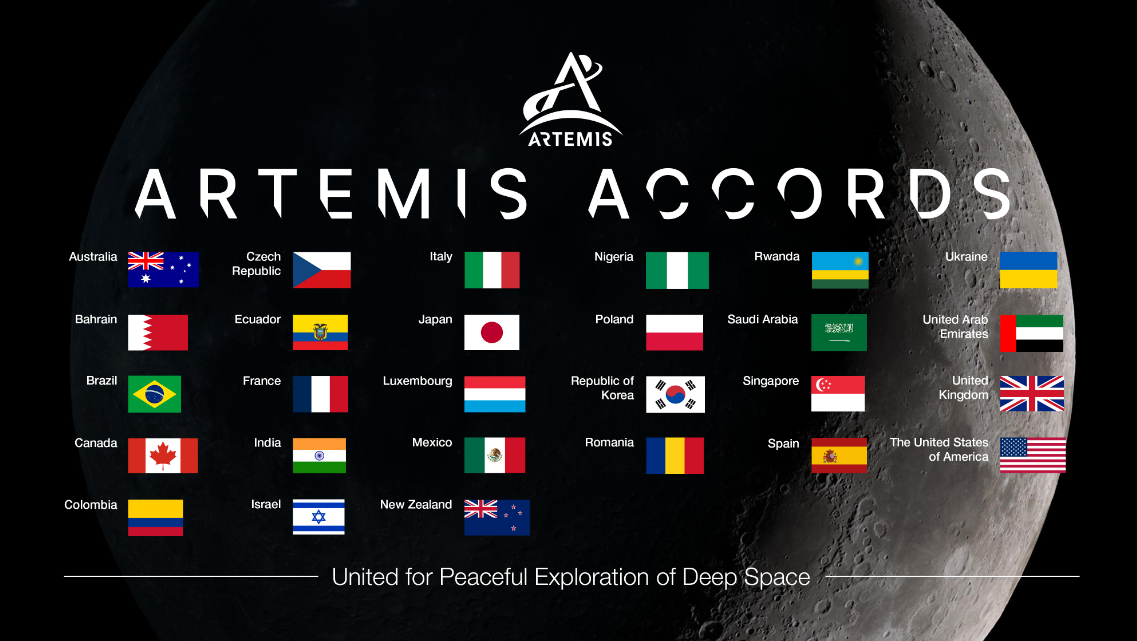Science & Technology
India Joins Artemis Accords
- 04 Jul 2023
- 7 min read
For Prelims: Artemis Accords , International Space Station, Outer Space Treaty of 1967, United Nations, Space Launch System, Chandrayaan-3 mission, Gaganyaan
For Mains: Missions under the Artemis Program
Why in News?
Recently, India's Prime Minister announced India's decision to join the Artemis Accords during the visit to the United States.
- National Aeronautics and Space Administration (NASA) and Indian Space Research Organisation (ISRO) will collaborate to send Indian astronauts, trained at the Johnson Space Center in Houston, Texas, to the International Space Station (ISS) in 2024.
What are Artemis Accords?
- About:
- Artemis Accords are established by the U.S. State Department and NASA with seven other founding members: Australia, Canada, Italy, Japan, Luxembourg, the United Arab Emirates, and the United Kingdom in 2020 for setting common principles to govern civil exploration and use of outer space, the moon, Mars, comets, and asteroids, for peaceful purposes.
- It builds upon the foundation of the Outer Space Treaty of 1967.
- The Outer Space Treaty, a multilateral pact under the United Nations, serves as the foundation for international space law.
- The treaty emphasizes space as a shared resource for humanity, prohibits national appropriation, and encourages the peaceful use of space.
- Signatory Countries:

- India became the 27th country to sign the nonbinding Artemis Accords.
- Commitments under the Accords:
- Peaceful Purposes: The signatories will implement memorandum of understanding (MOUs) between governments or agencies to conduct space activities for peaceful purposes in accordance with international law.
- Common Infrastructure: Signatories recognize the importance of common exploration infrastructure to enhance scientific discovery and commercial utilization.
- Registration and Data Sharing: Relevant space objects are registered, and scientific data is openly shared in a timely manner. Private sectors are exempt unless acting on behalf of a signatory.
- Preservation of Heritage: Signatories are expected to preserve historic landing sites, artifacts, and evidence of activity on celestial bodies.
- Utilization of Space Resources: Utilization of space resources should support safe and sustainable activities and not interfere with other signatories' activities. Information on location and nature must be shared to prevent interference.
- Mitigation of Debris: Signatories plan for the safe disposal of spacecraft and limit the generation of harmful debris.
What are the Main Missions under the Artemis Program?
- Artemis-I: Unmanned Mission to the Moon
- The Artemis program began with the launch of the spacecraft named "Orion" on the Space Launch System (SLS) from NASA's Kennedy Space Center on November 16, 2022.
- The SLS, a super heavy-lift launch vehicle, carried Orion on a single mission directly to the moon.
- Artemis-II: Crewed Lunar Flyby Mission:
- Scheduled for 2024, Artemis-II will mark the first crewed mission under the Artemis program.
- Four astronauts will be aboard the SLS as it performs multiple maneuvers on an expanding orbit around Earth.
- The mission will also involve a lunar flyby and return to Earth.
- Artemis-III: Human Return to the Moon:
- Set for 2025, Artemis-III will mark a significant milestone in human space exploration as astronauts return to the moon.
- This mission will go beyond the lunar flyby of Artemis-II, allowing astronauts to land on the lunar surface and study the moon more extensively.
- Also, the establishment of a Lunar Gateway station is planned for 2029. This station will serve as a docking point for astronauts and facilitate scientific research and experiments.
What are the Benefits and Challenges for India Related to the Accord?
- Benefits:
- India's participation in the Artemis Accords facilitates access to advanced training, technological advancements, and scientific opportunities.
- India can leverage the Artemis programme to advance its own lunar exploration goals, such as the Chandrayaan-3 mission.
- Collaborating with NASA would enhance India's capabilities for the Gaganyaan human mission and future ambitious space missions.
- Also, India's cost-effective missions and innovative approach will benefit the Artemis program, promoting mutual advancements in space exploration.
- Challenges:
- The possibility of being seen as aligning with the U.S. against other major space powers, such as China and Russia, who have their own plans for lunar exploration.
- The uncertainty over the legal status and implications of the Artemis Accords, especially regarding the provision that allows for unregulated mining on the moon and other celestial bodies.
- The need to balance its commitments under the Artemis Accords with its obligations under other existing or emerging multilateral frameworks or treaties on outer space.
UPSC Civil Services Examination, Previous Year Question (PYQ)
Prelims
Q. What is the purpose of the US Space Agency’s Themis Mission, which was recently in the news? (2008)
(a) To study the possibility of life on Mars
(b) To study the satellites of Saturn
(c) To study the colourful display of high latitude skies
(d) To build a space laboratory to study the stellar explosions
Ans: (c)
Q. Consider the following statements: (2016)
The Mangalyaan launched by ISRO
- is also called the Mars Orbiter Mission
- made India the second country to have a spacecraft orbit the Mars after USA
- made India the only country to be successful in making its spacecraft orbit the Mars in its very first attempt
Which of the statements given above is/are correct?
(a) 1 only
(b) 2 and 3 only
(c) 1 and 3 only
(d) 1, 2 and 3
Ans: (c)
Mains
Q.1 What is India’s plan to have its own space station and how will it benefit our space programme? (2019)
Q.2 Discuss India’s achievements in the field of Space Science and Technology. How the application of this technology has helped India in its socio-economic development? (2016)




